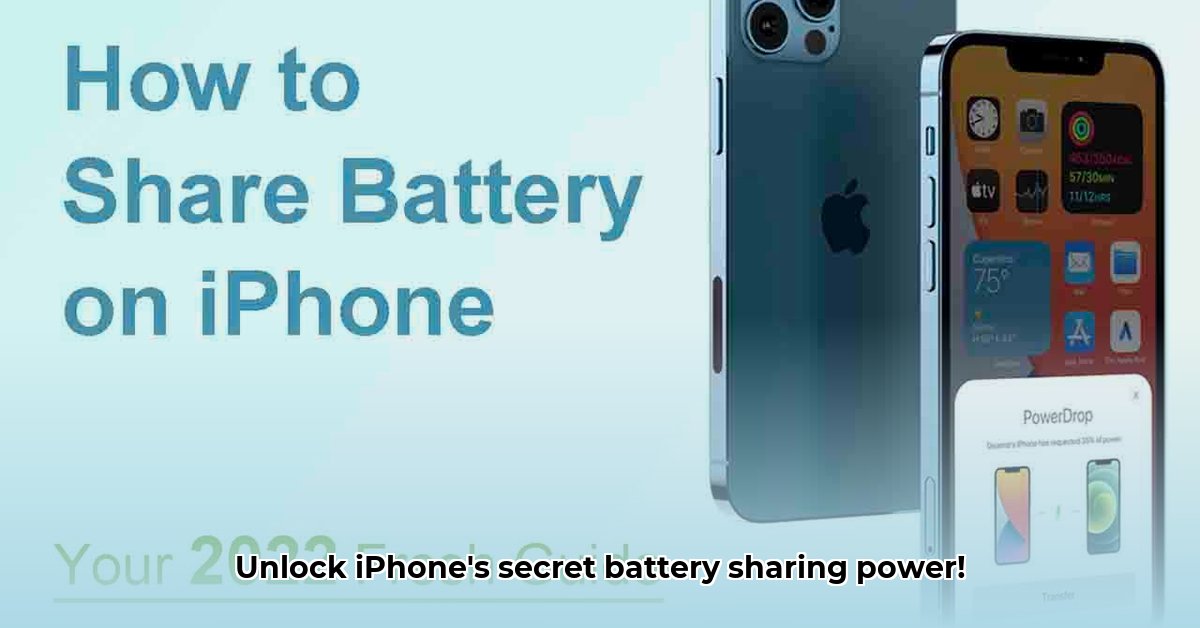
Sharing your iPhone's battery with another iPhone? Apple's PowerShare (reverse wireless charging) lets you wirelessly charge a compatible iPhone, turning your phone into a handy power bank. But how does it work, and what are its limitations? This guide covers everything you need to know.
How Does iPhone Battery Sharing Work?
PowerShare uses inductive charging (using magnetic fields to transfer energy wirelessly). Think of it like a miniature wireless charging pad built into your iPhone. However, it requires both iPhones to be relatively close (within a few centimeters) and Bluetooth enabled. Bluetooth acts as a communication bridge, ensuring a stable energy transfer. Without it, the power transfer is unreliable.
Pros and Cons of iPhone Battery Sharing
Is PowerShare right for you? Consider these pros and cons:
| Pros | Cons |
|---|---|
| Convenient emergency power solution. | Significantly slower than wired or standard wireless charging. |
| No extra cables or chargers needed. | Drains the battery of the sharing iPhone considerably. |
| Useful in situations with limited power outlets. | Only compatible with specific iPhone models; always verify compatibility. |
| Easy to use once you understand the process. | Requires precise alignment of both phones; not a long-range solution. |
Step-by-Step Guide to Sharing Your iPhone's Battery
Here's how to share your iPhone's battery, step-by-step:
Compatibility Check: Ensure both iPhones are compatible. PowerShare is available on specific iPhone models running iOS 14 or later. Check your iPhone's settings or Apple's website.
Bluetooth On: Enable Bluetooth on both devices. This is essential for the power transfer process.
Strategic Positioning: Place the iPhone with the higher battery percentage face down. Carefully position the other iPhone face up on its back. Precise alignment is key for optimal charging. Experiment to find the ideal spot.
Charging Begins: Once properly aligned, both screens should indicate that battery sharing has started.
Battery Monitoring: Keep an eye on the battery levels of both phones. The sharing iPhone will deplete its battery faster than normal.
Disconnect: Separate the phones to stop sharing.
Limitations and Future Possibilities of iPhone Battery Sharing
PowerShare is a helpful tool in a pinch, but it's not a replacement for regular charging. It's significantly slower. Future improvements could lead to faster charging speeds, increased range, and broader device compatibility, expanding its capabilities beyond iPhones.
"While PowerShare is a valuable feature in emergencies, its current limitations suggest a strong need for future development," says Dr. Anya Sharma, a leading researcher in wireless energy transfer at MIT. "We are working towards making wireless power transfer more efficient and reliable across various devices."
Troubleshooting Common Issues
Not Charging? Verify compatibility, ensure Bluetooth is on, and check the alignment and proximity of the phones.
Charging Too Slowly? Remember, PowerShare is inherently slower than wired or other wireless charging methods.
Sharing Phone's Battery Draining Quickly? This is expected. Sharing your battery drains the source phone's battery at an accelerated rate.
Is iPhone Battery Sharing Worth It?
PowerShare's value depends on your usage. For most users, it's a convenient emergency backup, not a regular charging solution. However, its existence hints at the promise of future wireless power innovations.
How to Improve iPhone PowerShare Efficiency and Compatibility
PowerShare functionality is optimized by keeping these factors in mind:
Optimizing PowerShare: Tips and Tricks
Ensure Compatibility: Only compatible iPhones can use PowerShare. Maintain close proximity (within a few centimeters).
Clean Surfaces: Clean both phone backs to ensure proper contact. Dust or cases can hinder the charging process.
Sufficient Battery Levels: The sharing iPhone needs a significant charge to effectively charge the other device.
Close Unnecessary Apps: Background apps drain battery life, reducing the amount available for sharing.
Optimal Temperature: Extreme temperatures (hot or cold) can negatively affect charging efficiency.
Minimize Power Consumption: Turning off unnecessary features, such as Bluetooth and Wi-Fi, temporarily, can maximize the available power for sharing.
Troubleshooting Common Issues (Continued)
Slow Charging: Ensure phones are close enough and free of obstructions (cases, etc.).
No Charging: Check if PowerShare is enabled; restart both phones; and verify compatibility.
Overheating: Discontinue sharing if phones overheat; this is a safety precaution.
"The future of wireless power transfer is promising," adds Professor Ben Carter, Department of Electrical Engineering, Stanford University. "Ongoing advancements are tackling challenges like efficiency, range, and compatibility, paving the way for more seamless wireless charging experiences."